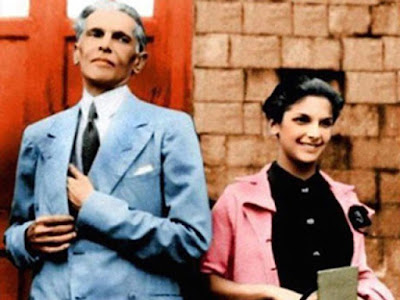Who was Rattanbai?.. Rattan bai Jinnah or Ruttie,
Muslim name was Maryam Jinnah. The year was February 1900 in the city of Mumbai,
Mumbai Presidency, British India. She belonged to a Parsi family. Her father
Sir Dinshaw Petit was a businessman and her family was one of the influential
families of that time. Rattanbai was the only daughter and was very pampered by
her family. She had three brothers. Rattanbai was a beautiful lady, an educated,
fashionable, and stylish woman. She always liked to wear sophisticated and
modern fashions, including silk and chiffon sarees, Jewelry. She loved to
delicately decorate her hair with beautiful flowers. She also loved horse
riding. She was called "Mumbai's flower".
She often chatted with Muhammad Ali Jinnah in Sir
Dinshaw's spacious and beautiful mansion in Malabar Hill, Mumbai. Ruttie was 16
years old when she fell in love with Muhammad Ali Jinnah, although there was a
24-years age difference between her and Jinnah.
However, Mr. Jinnah spoke to Mr. Dinshaw, about
marrying his daughter Ruttie. He became very angry. Jinnah's words surprised
him. Because, in his opinion, religion was not the only problem between them,
but the difference in their ages.
On February 20, 1918, Ruttie turned eighteen years old. Ruttie was connected with Mr.Jinnah through his sister Sheree Jinnah then Rattanbai decided to marry Mr.Jinnah. While she had accepted Islam in the Jamia Masjid of Mumbai at the hands of the famous religious scholar Maulana Nazir Ahmad her Muslim name was Maryam. On April 19, 1918, she entered the beautiful South Court Jinnah House, where Jinnah's family members, relatives, and some of his friends were present. On that day, Mr. Jinnah and Ruttie got married.
Ruttie's parents also came to know about the marriage
from newspapers on the second day that Ruttie had left her home. After this
marriage, Rati's parents never wanted to meet her again. Apart from her family,
her relationship with her Parsi community was severed.
Ruttie used to call her husband "J".
Muhammad Ali Jinnah also loved her immensely and did not refuse any desire for
his young wife.
After marriage, Mr. Jinnah & Mrs. Jinnah lived in
the South Court Palace on the Malabar Hills, which was the most expensive area
of Mumbai. In this house, three people lived there Mr. & Mrs. Jinnah, and
his younger sister Fatima Jinnah. Mr. & Mrs. Jinnah's mother tongue was
Gujarati, they spoke English at home and Gujarati with employees.
She always supported her husband in the freedom
struggle. Gandhiji often wrote political correspondence with Maryam Jinnah. He
believed that to make a flexible relationship with Mr. Jinnah, he need to
improve relations with Maryam Jinnah. So that he could convince Mr. Jinnah, but
this proved to be a misunderstanding of Gandhiji because Maryam Jinnah did not
disagree with anything with her husband.
She has always been a beacon for women. She traveled
with Mr. Jinnah on national and international tours including Canada, USA,
France, UK, and Ireland, and the beautiful land of Jammu and Kashmir.
An incident in this regard is also worth mentioning
after the marriage of Mrs. Maryam Jinnah, lady Willingdon invited Mr. &
Mrs. Jinnah to dinner at the Governor's House,
Mrs. Jinnah wore a stylish western dress which Lady Willingdon did not
like. The reason was that she thought that only English women could wear such
high-quality clothes so Lady Willingdon asked her ADC to bring a blanket for
Mrs. Jinnah as she must be getting cold. Maryam remained silent after her
comments, but Mr. Jinnah could not remain silent, he said If they feel cold,
they will tell, and after that, both of them left.
Maryam Jinnah's charismatic personality and sense of
humor made even his enemies become friends. For instance, Moti Lal Nehru always
felt pleasant in such gatherings where Maryam Jinnah was present. His daughter
Vijaya Lakshmi was her best friend.
Maryam's daughter Dina Jinnah was born on 15 August
1919 in London. Maryam Jinnah supported her husband Quaid-e-Azam Muhammad Ali
Jinnah at every moment of his life, whether it political, social, or marital
situations, but despite loving each other immensely, the situation came to such
a point in 1928 that, Maryam Jinnah was separated from her husband.
Some books have written, that the beginning of the differences was a cat. A cat of Maryam had been lost there at the hotel. Mr. Jinnah wanted to go back to Mumbai due to legal engagements as soon as possible, but before departure, one of Maryam Jinnah's cats went out of the hotel and was not found even after searching. Jinnah insisted on her return. But Maryam was not agreed. Finally, Jinnah left for Mumbai asking his lawyer friend Mrs. Sarojini Naidu to take care of her.
At the beginning of 1928, Maryam Jinnah was seriously ill. She was suffering from stomach and intestinal complications and it was a very old disease. Evidence of this is also found in Maryam Jinnah's letters and Dina Jinnah's confirmation. According to Dina Jinnah, her digestive system had deteriorated and the complications of the disease also increased with the passage of time.
Apart from this, she must also have suffered from
depression due to the separation and isolation from Jinnah. Mr. Jinnah followed
Maryam to London where he came to know that Maryam had gone to Paris.
Mr. Dewan Chaman Lal was the friend of Mr. Jinnah,
when Chaman Lal reached Paris, he found that Maryam was very ill and was
admitted to the hospital. He immediately went to the hospital to visit her and
also informed Jinnah about her condition.
Maryam was unconscious. Chaman Lal took care of her until
Mr. Jinnah arrived there. However, Mr. Jinnah reached the hospital after
hearing about her condition and encouraged Maryam. He shifted her to the
recognized best clinic in Paris, he continued to take care of her in the
hospital for 5 months. After 5 months she was discharged from the hospital and
moved to Mumbai at her brother Fram G’ s house.
After some time, due to the continuous efforts of Mrs.
Sarojini Naidu and Kanji Dwarkadas, the differences between Mr. & Mrs.
Jinnah began to wear off and after some time the situation improved to such an
extent that he was going there every evening, to take care of her.
There was no improvement in Maryam Jinnah's condition.
In the absence of Mr. Jinnah, generally, Kanji Dwarkadas, his wife, and Mrs.
Naidu looked after her. But in the last week of January 1929, when Jinnah went
to Delhi for a session of the Legislative Assembly. On February 19, 1929,
Maryam Jinnah's condition worsened. The employees informed Mr. Kanji and Maryam
Jinnah's parents that Maryam was unconscious and her condition was critical.
According to her daughter Dina, she had been suffering from severe stomach pain
for the last few days.
Mrs. Jinnah passed away on February 20, 1929, at the
age of 29 years, the same date of her birthday. Her father Mr. Dinshaw Petit
first called Jinnah in Delhi and asked him to come to Mumbai immediately but
did not tell him about Maryam's death.
Mr. Jinnah arrived in Mumbai, and it was a very sad day
for him. He made arrangements for the burial of Maryam Jinnah according to
Islamic beliefs. On February 22, before her funeral prayers, the body was
placed in Jinnah House South Court so that a large number of relatives,
friends, and admirers can reach there for condolence.
She was buried at Aram Bagh Cemetery in Mumbai.





.jpg)



Good content & informative
ReplyDelete